Organizational Behavior Analysis: CAPCO and Bibby Financial Services
VerifiedAdded on 2019/12/04
|15
|5150
|27
Report
AI Summary
This report provides a comprehensive analysis of organizational behavior, leadership, and management practices at CAPCO and Bibby Financial Services. It begins by comparing and contrasting the organizational structures and cultures of the two companies, highlighting the impact of these elements on operational effectiveness. The report then delves into the different leadership styles employed by each organization, evaluating their effectiveness and discussing the influence of organizational theories on management practices. Furthermore, the analysis explores factors influencing individual behavior, motivational strategies, and the impact of technology on teamwork within CAPCO. The report concludes with an evaluation of different management approaches and offers insights into the necessity of understanding and applying motivational theories in the workplace. It covers topics like flat structures, power cultures, autocratic and democratic leadership, and the application of scientific management and human relations theories. The report highlights how these elements influence employee behavior, team dynamics, and overall organizational performance.
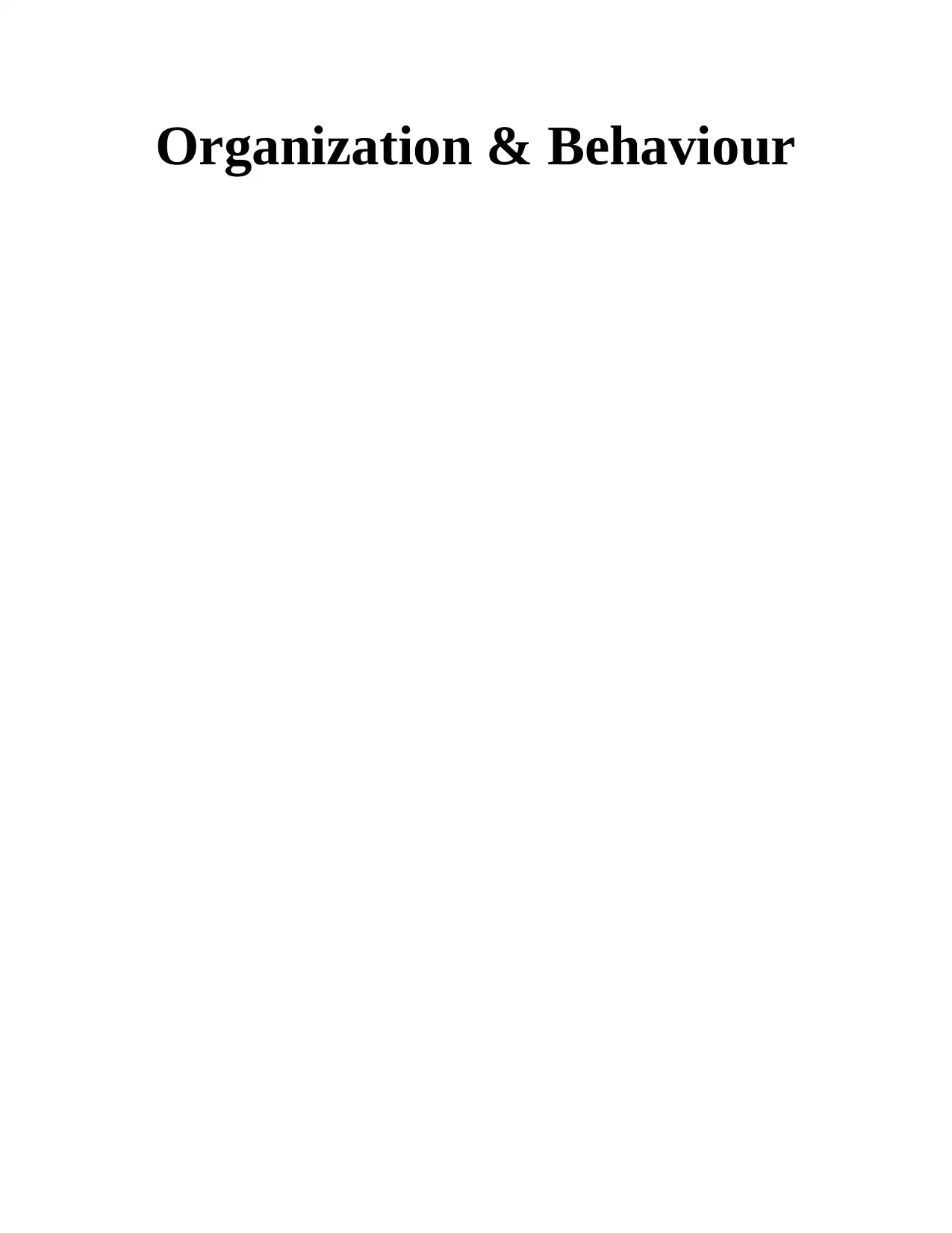
Organization & Behaviour
Paraphrase This Document
Need a fresh take? Get an instant paraphrase of this document with our AI Paraphraser

TABLE OF CONTENTS
INTRODUCTION...........................................................................................................................3
TASK 1............................................................................................................................................3
1.1 Comparing and contrast the structure and culture of CAPCO and Bibby financial services
organization ................................................................................................................................3
1.2 Relationship between culture and structure can impact the operations of company.............4
1.3 Discussing the factors which influence individual behavior in CAPCO and Bibby financial
services.........................................................................................................................................4
M1................................................................................................................................................5
TASK 2............................................................................................................................................6
2.1 Comparing the effectiveness of different leadership at CAPCO and Bibby financial
services.........................................................................................................................................6
2.2 Influence of organizational theories on practice of management..........................................6
D1.................................................................................................................................................7
2.3 Evaluating different approaches to management used by CAPCO.......................................7
M2................................................................................................................................................8
TASK 3............................................................................................................................................8
3.1 Discussing the impact of different leadership styles may have on motivation within period
of change......................................................................................................................................8
3.2 Comparing the application of two motivational theories.......................................................9
D2...............................................................................................................................................10
3.3 Explaining the necessity of managers to understand and apply motivational theories at
workplace...................................................................................................................................10
TASK 4..........................................................................................................................................11
4.1 Nature of groups and group behaviour withing CAPCO.....................................................11
4.2 Discussing factors that may promote or inhibit the development of effective teamwork...11
4.3 Evaluating the impact of technology on team functioning within CAPCO........................12
M3..............................................................................................................................................13
D3...............................................................................................................................................13
CONCLUSION..............................................................................................................................13
REFERENCES..............................................................................................................................14
2
INTRODUCTION...........................................................................................................................3
TASK 1............................................................................................................................................3
1.1 Comparing and contrast the structure and culture of CAPCO and Bibby financial services
organization ................................................................................................................................3
1.2 Relationship between culture and structure can impact the operations of company.............4
1.3 Discussing the factors which influence individual behavior in CAPCO and Bibby financial
services.........................................................................................................................................4
M1................................................................................................................................................5
TASK 2............................................................................................................................................6
2.1 Comparing the effectiveness of different leadership at CAPCO and Bibby financial
services.........................................................................................................................................6
2.2 Influence of organizational theories on practice of management..........................................6
D1.................................................................................................................................................7
2.3 Evaluating different approaches to management used by CAPCO.......................................7
M2................................................................................................................................................8
TASK 3............................................................................................................................................8
3.1 Discussing the impact of different leadership styles may have on motivation within period
of change......................................................................................................................................8
3.2 Comparing the application of two motivational theories.......................................................9
D2...............................................................................................................................................10
3.3 Explaining the necessity of managers to understand and apply motivational theories at
workplace...................................................................................................................................10
TASK 4..........................................................................................................................................11
4.1 Nature of groups and group behaviour withing CAPCO.....................................................11
4.2 Discussing factors that may promote or inhibit the development of effective teamwork...11
4.3 Evaluating the impact of technology on team functioning within CAPCO........................12
M3..............................................................................................................................................13
D3...............................................................................................................................................13
CONCLUSION..............................................................................................................................13
REFERENCES..............................................................................................................................14
2
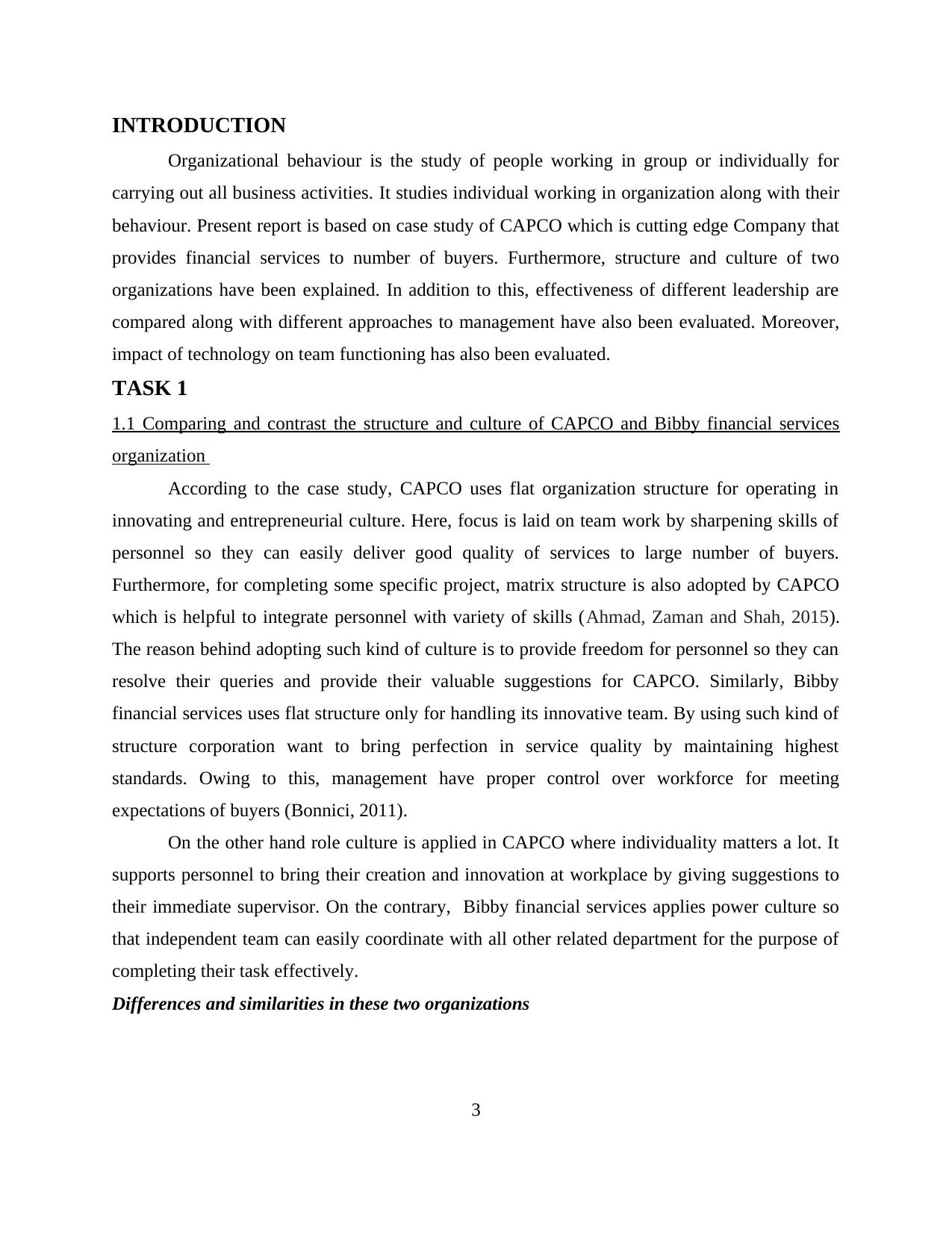
INTRODUCTION
Organizational behaviour is the study of people working in group or individually for
carrying out all business activities. It studies individual working in organization along with their
behaviour. Present report is based on case study of CAPCO which is cutting edge Company that
provides financial services to number of buyers. Furthermore, structure and culture of two
organizations have been explained. In addition to this, effectiveness of different leadership are
compared along with different approaches to management have also been evaluated. Moreover,
impact of technology on team functioning has also been evaluated.
TASK 1
1.1 Comparing and contrast the structure and culture of CAPCO and Bibby financial services
organization
According to the case study, CAPCO uses flat organization structure for operating in
innovating and entrepreneurial culture. Here, focus is laid on team work by sharpening skills of
personnel so they can easily deliver good quality of services to large number of buyers.
Furthermore, for completing some specific project, matrix structure is also adopted by CAPCO
which is helpful to integrate personnel with variety of skills (Ahmad, Zaman and Shah, 2015).
The reason behind adopting such kind of culture is to provide freedom for personnel so they can
resolve their queries and provide their valuable suggestions for CAPCO. Similarly, Bibby
financial services uses flat structure only for handling its innovative team. By using such kind of
structure corporation want to bring perfection in service quality by maintaining highest
standards. Owing to this, management have proper control over workforce for meeting
expectations of buyers (Bonnici, 2011).
On the other hand role culture is applied in CAPCO where individuality matters a lot. It
supports personnel to bring their creation and innovation at workplace by giving suggestions to
their immediate supervisor. On the contrary, Bibby financial services applies power culture so
that independent team can easily coordinate with all other related department for the purpose of
completing their task effectively.
Differences and similarities in these two organizations
3
Organizational behaviour is the study of people working in group or individually for
carrying out all business activities. It studies individual working in organization along with their
behaviour. Present report is based on case study of CAPCO which is cutting edge Company that
provides financial services to number of buyers. Furthermore, structure and culture of two
organizations have been explained. In addition to this, effectiveness of different leadership are
compared along with different approaches to management have also been evaluated. Moreover,
impact of technology on team functioning has also been evaluated.
TASK 1
1.1 Comparing and contrast the structure and culture of CAPCO and Bibby financial services
organization
According to the case study, CAPCO uses flat organization structure for operating in
innovating and entrepreneurial culture. Here, focus is laid on team work by sharpening skills of
personnel so they can easily deliver good quality of services to large number of buyers.
Furthermore, for completing some specific project, matrix structure is also adopted by CAPCO
which is helpful to integrate personnel with variety of skills (Ahmad, Zaman and Shah, 2015).
The reason behind adopting such kind of culture is to provide freedom for personnel so they can
resolve their queries and provide their valuable suggestions for CAPCO. Similarly, Bibby
financial services uses flat structure only for handling its innovative team. By using such kind of
structure corporation want to bring perfection in service quality by maintaining highest
standards. Owing to this, management have proper control over workforce for meeting
expectations of buyers (Bonnici, 2011).
On the other hand role culture is applied in CAPCO where individuality matters a lot. It
supports personnel to bring their creation and innovation at workplace by giving suggestions to
their immediate supervisor. On the contrary, Bibby financial services applies power culture so
that independent team can easily coordinate with all other related department for the purpose of
completing their task effectively.
Differences and similarities in these two organizations
3
⊘ This is a preview!⊘
Do you want full access?
Subscribe today to unlock all pages.

Trusted by 1+ million students worldwide
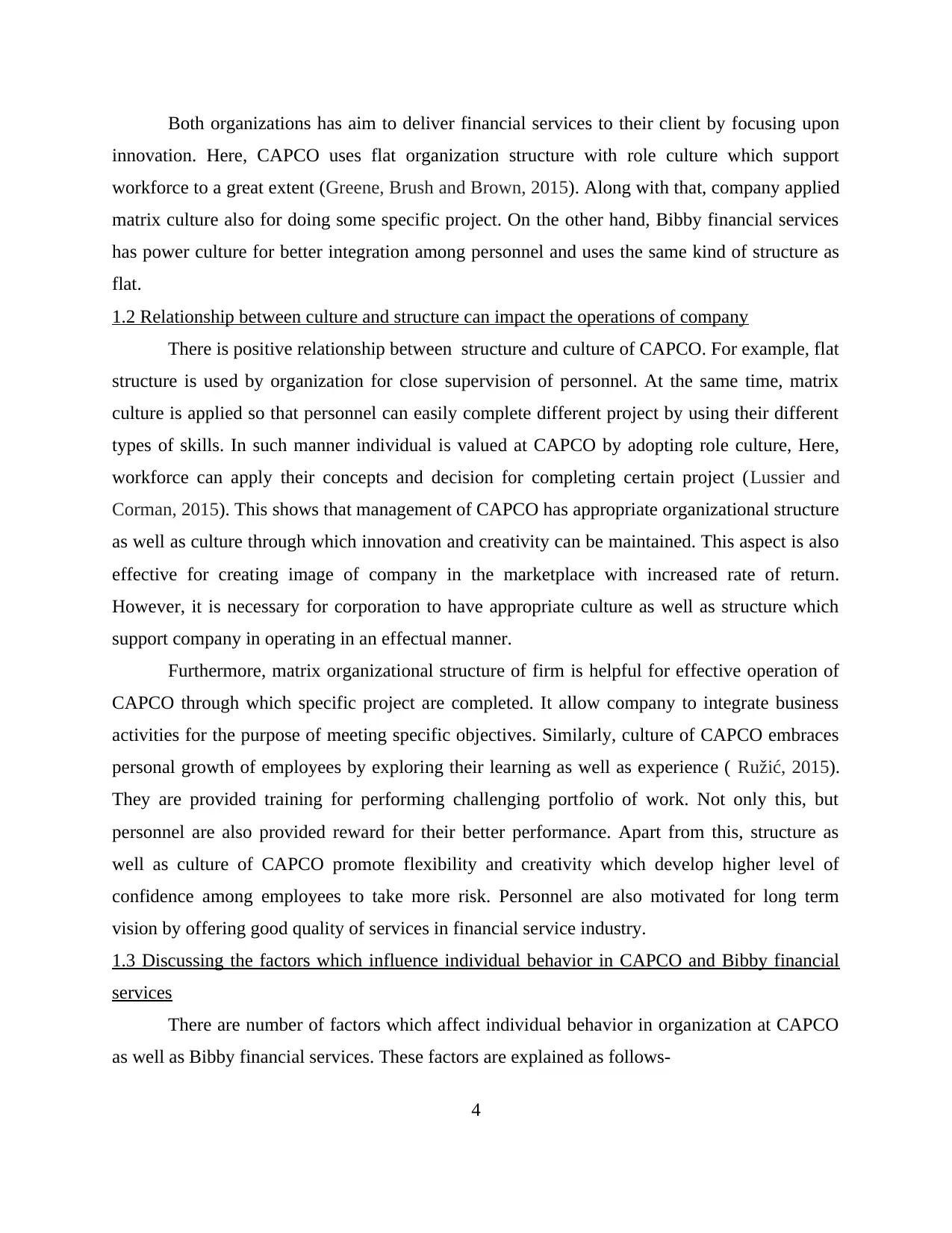
Both organizations has aim to deliver financial services to their client by focusing upon
innovation. Here, CAPCO uses flat organization structure with role culture which support
workforce to a great extent (Greene, Brush and Brown, 2015). Along with that, company applied
matrix culture also for doing some specific project. On the other hand, Bibby financial services
has power culture for better integration among personnel and uses the same kind of structure as
flat.
1.2 Relationship between culture and structure can impact the operations of company
There is positive relationship between structure and culture of CAPCO. For example, flat
structure is used by organization for close supervision of personnel. At the same time, matrix
culture is applied so that personnel can easily complete different project by using their different
types of skills. In such manner individual is valued at CAPCO by adopting role culture, Here,
workforce can apply their concepts and decision for completing certain project (Lussier and
Corman, 2015). This shows that management of CAPCO has appropriate organizational structure
as well as culture through which innovation and creativity can be maintained. This aspect is also
effective for creating image of company in the marketplace with increased rate of return.
However, it is necessary for corporation to have appropriate culture as well as structure which
support company in operating in an effectual manner.
Furthermore, matrix organizational structure of firm is helpful for effective operation of
CAPCO through which specific project are completed. It allow company to integrate business
activities for the purpose of meeting specific objectives. Similarly, culture of CAPCO embraces
personal growth of employees by exploring their learning as well as experience ( Ružić, 2015).
They are provided training for performing challenging portfolio of work. Not only this, but
personnel are also provided reward for their better performance. Apart from this, structure as
well as culture of CAPCO promote flexibility and creativity which develop higher level of
confidence among employees to take more risk. Personnel are also motivated for long term
vision by offering good quality of services in financial service industry.
1.3 Discussing the factors which influence individual behavior in CAPCO and Bibby financial
services
There are number of factors which affect individual behavior in organization at CAPCO
as well as Bibby financial services. These factors are explained as follows-
4
innovation. Here, CAPCO uses flat organization structure with role culture which support
workforce to a great extent (Greene, Brush and Brown, 2015). Along with that, company applied
matrix culture also for doing some specific project. On the other hand, Bibby financial services
has power culture for better integration among personnel and uses the same kind of structure as
flat.
1.2 Relationship between culture and structure can impact the operations of company
There is positive relationship between structure and culture of CAPCO. For example, flat
structure is used by organization for close supervision of personnel. At the same time, matrix
culture is applied so that personnel can easily complete different project by using their different
types of skills. In such manner individual is valued at CAPCO by adopting role culture, Here,
workforce can apply their concepts and decision for completing certain project (Lussier and
Corman, 2015). This shows that management of CAPCO has appropriate organizational structure
as well as culture through which innovation and creativity can be maintained. This aspect is also
effective for creating image of company in the marketplace with increased rate of return.
However, it is necessary for corporation to have appropriate culture as well as structure which
support company in operating in an effectual manner.
Furthermore, matrix organizational structure of firm is helpful for effective operation of
CAPCO through which specific project are completed. It allow company to integrate business
activities for the purpose of meeting specific objectives. Similarly, culture of CAPCO embraces
personal growth of employees by exploring their learning as well as experience ( Ružić, 2015).
They are provided training for performing challenging portfolio of work. Not only this, but
personnel are also provided reward for their better performance. Apart from this, structure as
well as culture of CAPCO promote flexibility and creativity which develop higher level of
confidence among employees to take more risk. Personnel are also motivated for long term
vision by offering good quality of services in financial service industry.
1.3 Discussing the factors which influence individual behavior in CAPCO and Bibby financial
services
There are number of factors which affect individual behavior in organization at CAPCO
as well as Bibby financial services. These factors are explained as follows-
4
Paraphrase This Document
Need a fresh take? Get an instant paraphrase of this document with our AI Paraphraser
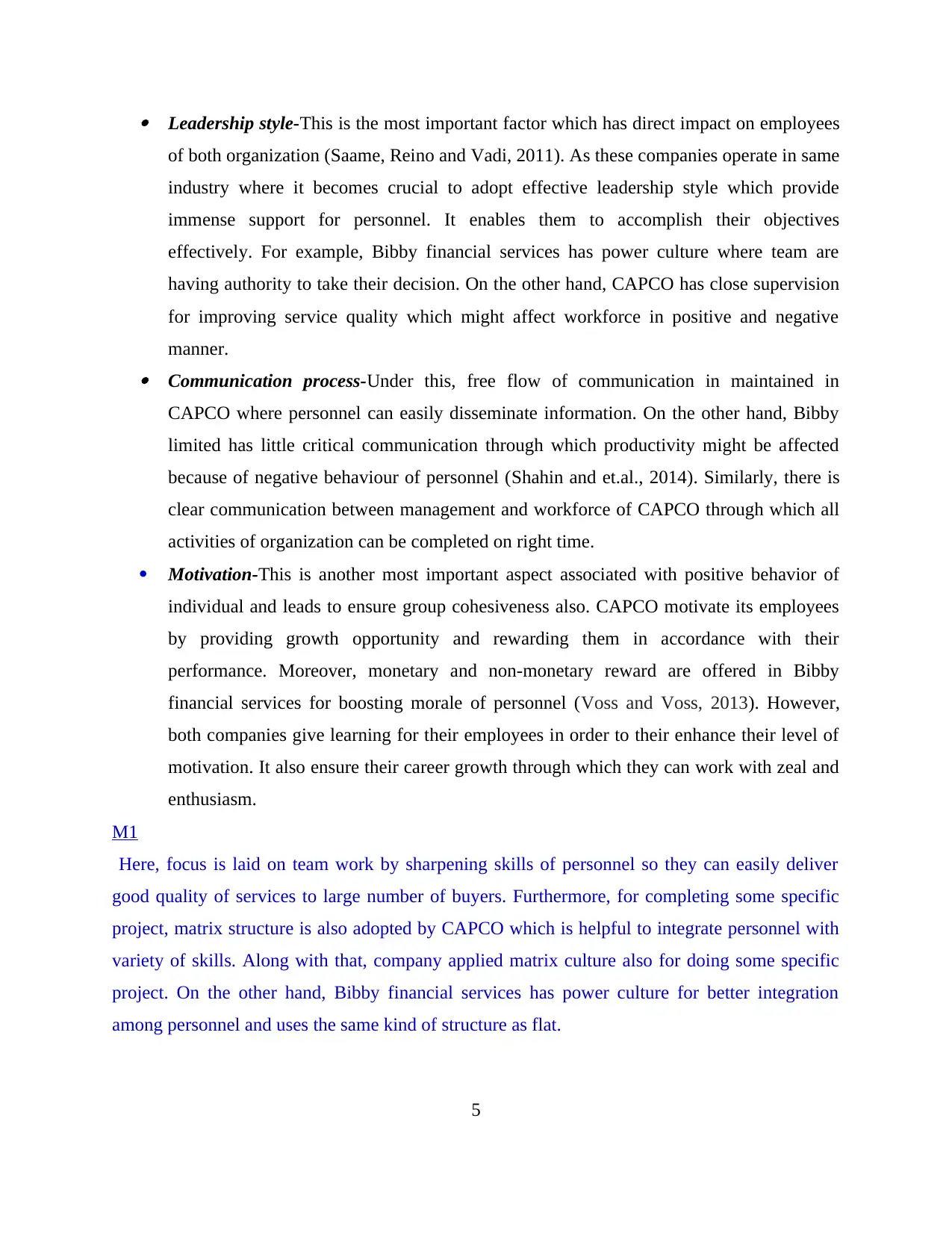
Leadership style-This is the most important factor which has direct impact on employees
of both organization (Saame, Reino and Vadi, 2011). As these companies operate in same
industry where it becomes crucial to adopt effective leadership style which provide
immense support for personnel. It enables them to accomplish their objectives
effectively. For example, Bibby financial services has power culture where team are
having authority to take their decision. On the other hand, CAPCO has close supervision
for improving service quality which might affect workforce in positive and negative
manner. Communication process-Under this, free flow of communication in maintained in
CAPCO where personnel can easily disseminate information. On the other hand, Bibby
limited has little critical communication through which productivity might be affected
because of negative behaviour of personnel (Shahin and et.al., 2014). Similarly, there is
clear communication between management and workforce of CAPCO through which all
activities of organization can be completed on right time.
Motivation-This is another most important aspect associated with positive behavior of
individual and leads to ensure group cohesiveness also. CAPCO motivate its employees
by providing growth opportunity and rewarding them in accordance with their
performance. Moreover, monetary and non-monetary reward are offered in Bibby
financial services for boosting morale of personnel (Voss and Voss, 2013). However,
both companies give learning for their employees in order to their enhance their level of
motivation. It also ensure their career growth through which they can work with zeal and
enthusiasm.
M1
Here, focus is laid on team work by sharpening skills of personnel so they can easily deliver
good quality of services to large number of buyers. Furthermore, for completing some specific
project, matrix structure is also adopted by CAPCO which is helpful to integrate personnel with
variety of skills. Along with that, company applied matrix culture also for doing some specific
project. On the other hand, Bibby financial services has power culture for better integration
among personnel and uses the same kind of structure as flat.
5
of both organization (Saame, Reino and Vadi, 2011). As these companies operate in same
industry where it becomes crucial to adopt effective leadership style which provide
immense support for personnel. It enables them to accomplish their objectives
effectively. For example, Bibby financial services has power culture where team are
having authority to take their decision. On the other hand, CAPCO has close supervision
for improving service quality which might affect workforce in positive and negative
manner. Communication process-Under this, free flow of communication in maintained in
CAPCO where personnel can easily disseminate information. On the other hand, Bibby
limited has little critical communication through which productivity might be affected
because of negative behaviour of personnel (Shahin and et.al., 2014). Similarly, there is
clear communication between management and workforce of CAPCO through which all
activities of organization can be completed on right time.
Motivation-This is another most important aspect associated with positive behavior of
individual and leads to ensure group cohesiveness also. CAPCO motivate its employees
by providing growth opportunity and rewarding them in accordance with their
performance. Moreover, monetary and non-monetary reward are offered in Bibby
financial services for boosting morale of personnel (Voss and Voss, 2013). However,
both companies give learning for their employees in order to their enhance their level of
motivation. It also ensure their career growth through which they can work with zeal and
enthusiasm.
M1
Here, focus is laid on team work by sharpening skills of personnel so they can easily deliver
good quality of services to large number of buyers. Furthermore, for completing some specific
project, matrix structure is also adopted by CAPCO which is helpful to integrate personnel with
variety of skills. Along with that, company applied matrix culture also for doing some specific
project. On the other hand, Bibby financial services has power culture for better integration
among personnel and uses the same kind of structure as flat.
5
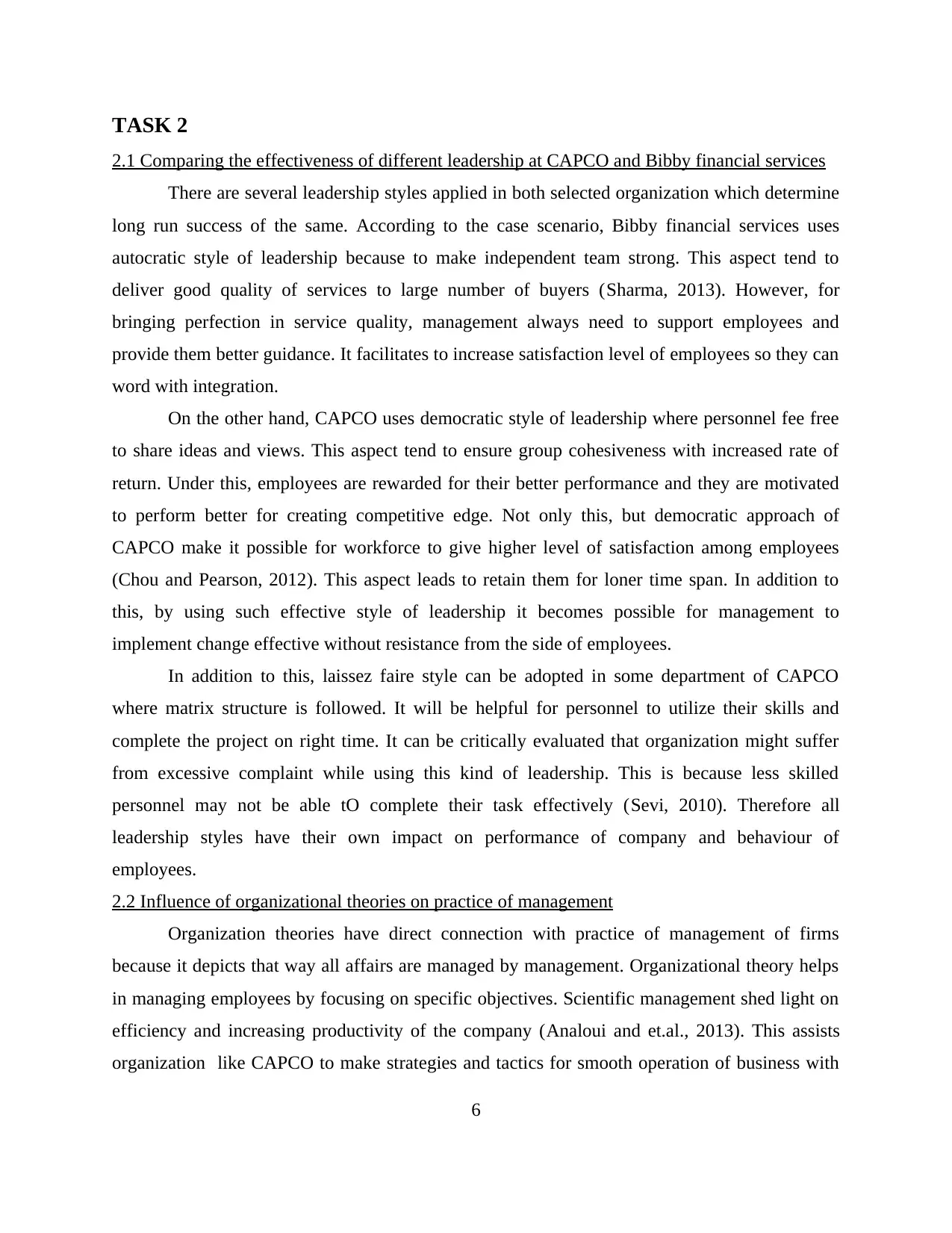
TASK 2
2.1 Comparing the effectiveness of different leadership at CAPCO and Bibby financial services
There are several leadership styles applied in both selected organization which determine
long run success of the same. According to the case scenario, Bibby financial services uses
autocratic style of leadership because to make independent team strong. This aspect tend to
deliver good quality of services to large number of buyers (Sharma, 2013). However, for
bringing perfection in service quality, management always need to support employees and
provide them better guidance. It facilitates to increase satisfaction level of employees so they can
word with integration.
On the other hand, CAPCO uses democratic style of leadership where personnel fee free
to share ideas and views. This aspect tend to ensure group cohesiveness with increased rate of
return. Under this, employees are rewarded for their better performance and they are motivated
to perform better for creating competitive edge. Not only this, but democratic approach of
CAPCO make it possible for workforce to give higher level of satisfaction among employees
(Chou and Pearson, 2012). This aspect leads to retain them for loner time span. In addition to
this, by using such effective style of leadership it becomes possible for management to
implement change effective without resistance from the side of employees.
In addition to this, laissez faire style can be adopted in some department of CAPCO
where matrix structure is followed. It will be helpful for personnel to utilize their skills and
complete the project on right time. It can be critically evaluated that organization might suffer
from excessive complaint while using this kind of leadership. This is because less skilled
personnel may not be able tO complete their task effectively (Sevi, 2010). Therefore all
leadership styles have their own impact on performance of company and behaviour of
employees.
2.2 Influence of organizational theories on practice of management
Organization theories have direct connection with practice of management of firms
because it depicts that way all affairs are managed by management. Organizational theory helps
in managing employees by focusing on specific objectives. Scientific management shed light on
efficiency and increasing productivity of the company (Analoui and et.al., 2013). This assists
organization like CAPCO to make strategies and tactics for smooth operation of business with
6
2.1 Comparing the effectiveness of different leadership at CAPCO and Bibby financial services
There are several leadership styles applied in both selected organization which determine
long run success of the same. According to the case scenario, Bibby financial services uses
autocratic style of leadership because to make independent team strong. This aspect tend to
deliver good quality of services to large number of buyers (Sharma, 2013). However, for
bringing perfection in service quality, management always need to support employees and
provide them better guidance. It facilitates to increase satisfaction level of employees so they can
word with integration.
On the other hand, CAPCO uses democratic style of leadership where personnel fee free
to share ideas and views. This aspect tend to ensure group cohesiveness with increased rate of
return. Under this, employees are rewarded for their better performance and they are motivated
to perform better for creating competitive edge. Not only this, but democratic approach of
CAPCO make it possible for workforce to give higher level of satisfaction among employees
(Chou and Pearson, 2012). This aspect leads to retain them for loner time span. In addition to
this, by using such effective style of leadership it becomes possible for management to
implement change effective without resistance from the side of employees.
In addition to this, laissez faire style can be adopted in some department of CAPCO
where matrix structure is followed. It will be helpful for personnel to utilize their skills and
complete the project on right time. It can be critically evaluated that organization might suffer
from excessive complaint while using this kind of leadership. This is because less skilled
personnel may not be able tO complete their task effectively (Sevi, 2010). Therefore all
leadership styles have their own impact on performance of company and behaviour of
employees.
2.2 Influence of organizational theories on practice of management
Organization theories have direct connection with practice of management of firms
because it depicts that way all affairs are managed by management. Organizational theory helps
in managing employees by focusing on specific objectives. Scientific management shed light on
efficiency and increasing productivity of the company (Analoui and et.al., 2013). This assists
organization like CAPCO to make strategies and tactics for smooth operation of business with
6
⊘ This is a preview!⊘
Do you want full access?
Subscribe today to unlock all pages.

Trusted by 1+ million students worldwide
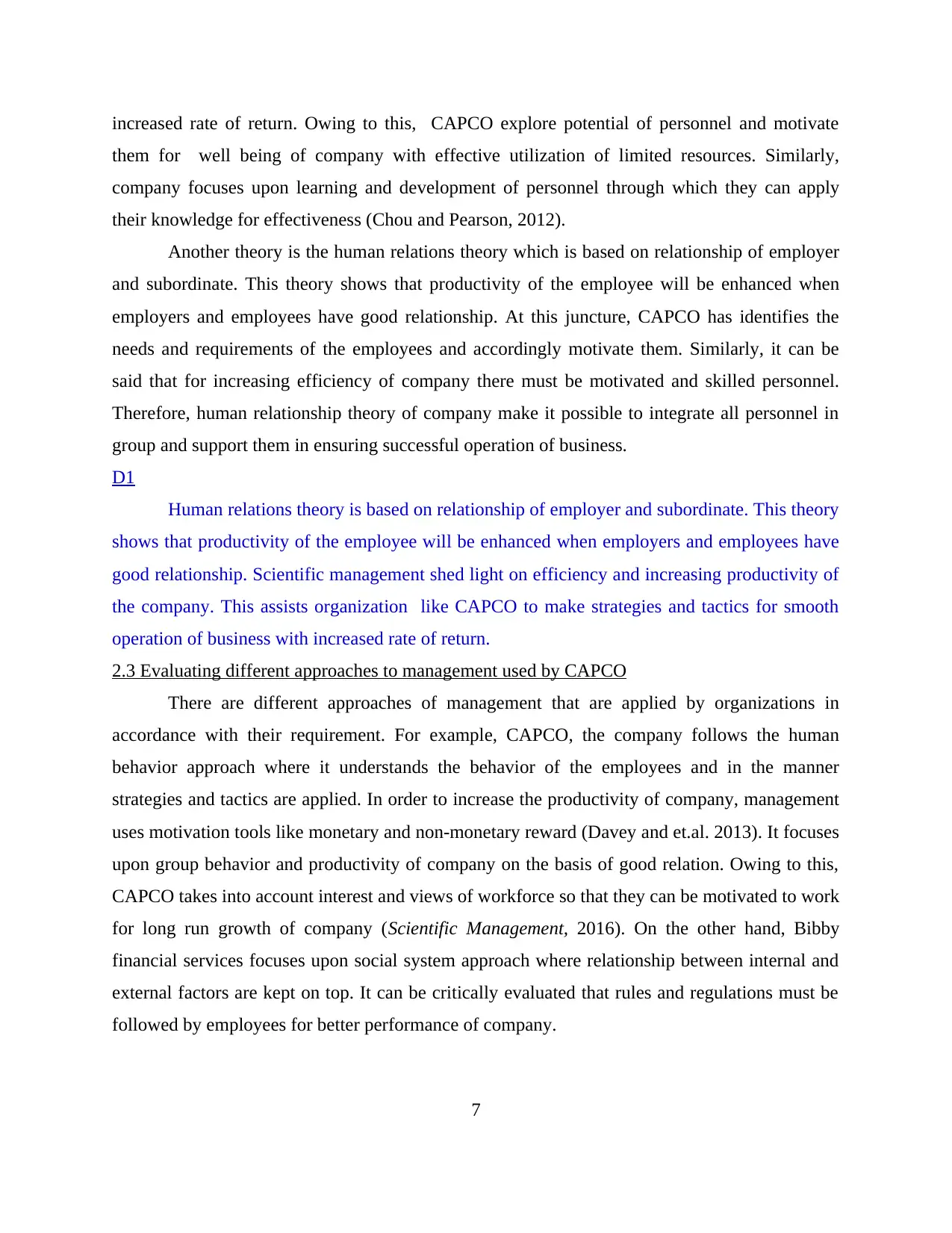
increased rate of return. Owing to this, CAPCO explore potential of personnel and motivate
them for well being of company with effective utilization of limited resources. Similarly,
company focuses upon learning and development of personnel through which they can apply
their knowledge for effectiveness (Chou and Pearson, 2012).
Another theory is the human relations theory which is based on relationship of employer
and subordinate. This theory shows that productivity of the employee will be enhanced when
employers and employees have good relationship. At this juncture, CAPCO has identifies the
needs and requirements of the employees and accordingly motivate them. Similarly, it can be
said that for increasing efficiency of company there must be motivated and skilled personnel.
Therefore, human relationship theory of company make it possible to integrate all personnel in
group and support them in ensuring successful operation of business.
D1
Human relations theory is based on relationship of employer and subordinate. This theory
shows that productivity of the employee will be enhanced when employers and employees have
good relationship. Scientific management shed light on efficiency and increasing productivity of
the company. This assists organization like CAPCO to make strategies and tactics for smooth
operation of business with increased rate of return.
2.3 Evaluating different approaches to management used by CAPCO
There are different approaches of management that are applied by organizations in
accordance with their requirement. For example, CAPCO, the company follows the human
behavior approach where it understands the behavior of the employees and in the manner
strategies and tactics are applied. In order to increase the productivity of company, management
uses motivation tools like monetary and non-monetary reward (Davey and et.al. 2013). It focuses
upon group behavior and productivity of company on the basis of good relation. Owing to this,
CAPCO takes into account interest and views of workforce so that they can be motivated to work
for long run growth of company (Scientific Management, 2016). On the other hand, Bibby
financial services focuses upon social system approach where relationship between internal and
external factors are kept on top. It can be critically evaluated that rules and regulations must be
followed by employees for better performance of company.
7
them for well being of company with effective utilization of limited resources. Similarly,
company focuses upon learning and development of personnel through which they can apply
their knowledge for effectiveness (Chou and Pearson, 2012).
Another theory is the human relations theory which is based on relationship of employer
and subordinate. This theory shows that productivity of the employee will be enhanced when
employers and employees have good relationship. At this juncture, CAPCO has identifies the
needs and requirements of the employees and accordingly motivate them. Similarly, it can be
said that for increasing efficiency of company there must be motivated and skilled personnel.
Therefore, human relationship theory of company make it possible to integrate all personnel in
group and support them in ensuring successful operation of business.
D1
Human relations theory is based on relationship of employer and subordinate. This theory
shows that productivity of the employee will be enhanced when employers and employees have
good relationship. Scientific management shed light on efficiency and increasing productivity of
the company. This assists organization like CAPCO to make strategies and tactics for smooth
operation of business with increased rate of return.
2.3 Evaluating different approaches to management used by CAPCO
There are different approaches of management that are applied by organizations in
accordance with their requirement. For example, CAPCO, the company follows the human
behavior approach where it understands the behavior of the employees and in the manner
strategies and tactics are applied. In order to increase the productivity of company, management
uses motivation tools like monetary and non-monetary reward (Davey and et.al. 2013). It focuses
upon group behavior and productivity of company on the basis of good relation. Owing to this,
CAPCO takes into account interest and views of workforce so that they can be motivated to work
for long run growth of company (Scientific Management, 2016). On the other hand, Bibby
financial services focuses upon social system approach where relationship between internal and
external factors are kept on top. It can be critically evaluated that rules and regulations must be
followed by employees for better performance of company.
7
Paraphrase This Document
Need a fresh take? Get an instant paraphrase of this document with our AI Paraphraser
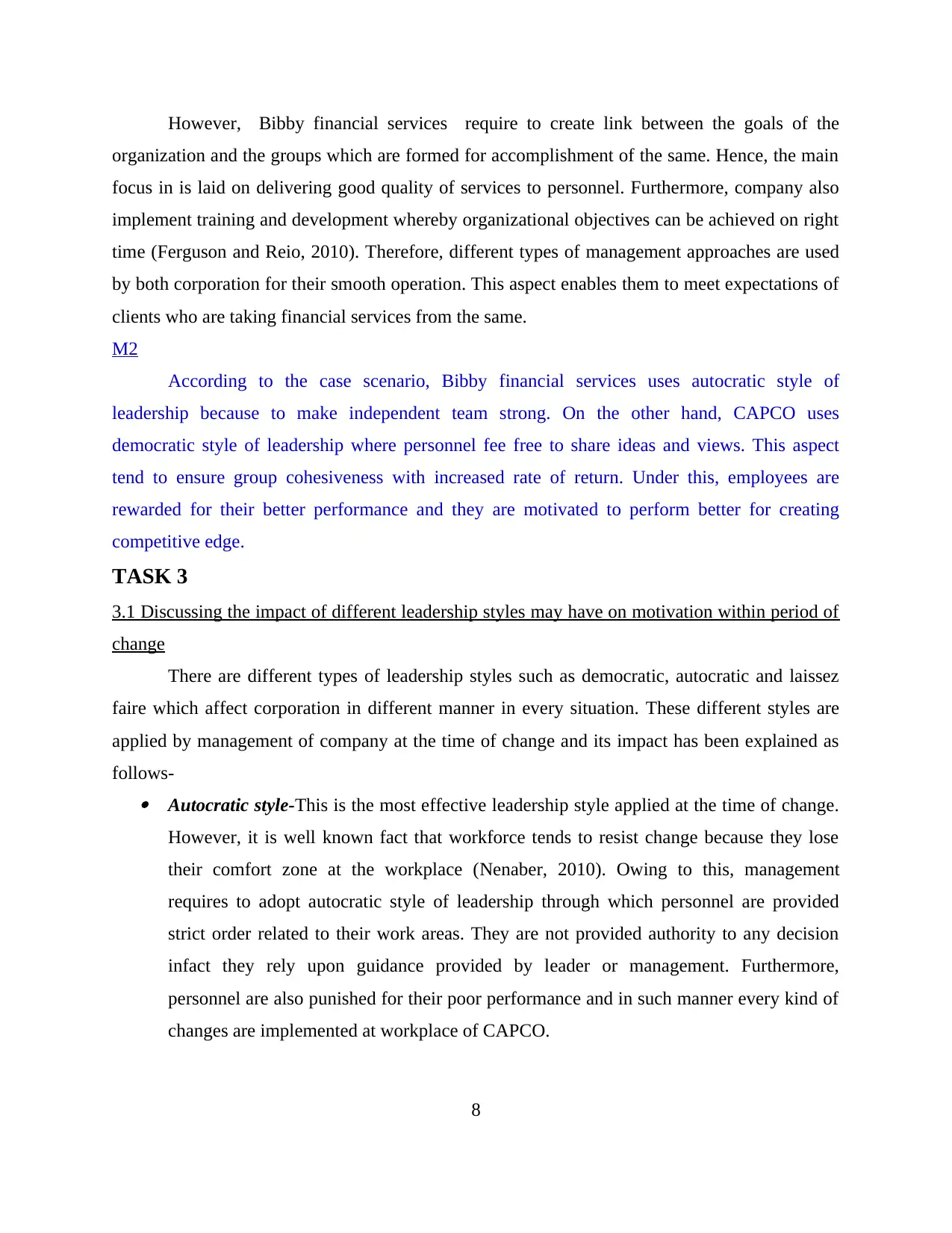
However, Bibby financial services require to create link between the goals of the
organization and the groups which are formed for accomplishment of the same. Hence, the main
focus in is laid on delivering good quality of services to personnel. Furthermore, company also
implement training and development whereby organizational objectives can be achieved on right
time (Ferguson and Reio, 2010). Therefore, different types of management approaches are used
by both corporation for their smooth operation. This aspect enables them to meet expectations of
clients who are taking financial services from the same.
M2
According to the case scenario, Bibby financial services uses autocratic style of
leadership because to make independent team strong. On the other hand, CAPCO uses
democratic style of leadership where personnel fee free to share ideas and views. This aspect
tend to ensure group cohesiveness with increased rate of return. Under this, employees are
rewarded for their better performance and they are motivated to perform better for creating
competitive edge.
TASK 3
3.1 Discussing the impact of different leadership styles may have on motivation within period of
change
There are different types of leadership styles such as democratic, autocratic and laissez
faire which affect corporation in different manner in every situation. These different styles are
applied by management of company at the time of change and its impact has been explained as
follows- Autocratic style-This is the most effective leadership style applied at the time of change.
However, it is well known fact that workforce tends to resist change because they lose
their comfort zone at the workplace (Nenaber, 2010). Owing to this, management
requires to adopt autocratic style of leadership through which personnel are provided
strict order related to their work areas. They are not provided authority to any decision
infact they rely upon guidance provided by leader or management. Furthermore,
personnel are also punished for their poor performance and in such manner every kind of
changes are implemented at workplace of CAPCO.
8
organization and the groups which are formed for accomplishment of the same. Hence, the main
focus in is laid on delivering good quality of services to personnel. Furthermore, company also
implement training and development whereby organizational objectives can be achieved on right
time (Ferguson and Reio, 2010). Therefore, different types of management approaches are used
by both corporation for their smooth operation. This aspect enables them to meet expectations of
clients who are taking financial services from the same.
M2
According to the case scenario, Bibby financial services uses autocratic style of
leadership because to make independent team strong. On the other hand, CAPCO uses
democratic style of leadership where personnel fee free to share ideas and views. This aspect
tend to ensure group cohesiveness with increased rate of return. Under this, employees are
rewarded for their better performance and they are motivated to perform better for creating
competitive edge.
TASK 3
3.1 Discussing the impact of different leadership styles may have on motivation within period of
change
There are different types of leadership styles such as democratic, autocratic and laissez
faire which affect corporation in different manner in every situation. These different styles are
applied by management of company at the time of change and its impact has been explained as
follows- Autocratic style-This is the most effective leadership style applied at the time of change.
However, it is well known fact that workforce tends to resist change because they lose
their comfort zone at the workplace (Nenaber, 2010). Owing to this, management
requires to adopt autocratic style of leadership through which personnel are provided
strict order related to their work areas. They are not provided authority to any decision
infact they rely upon guidance provided by leader or management. Furthermore,
personnel are also punished for their poor performance and in such manner every kind of
changes are implemented at workplace of CAPCO.
8

Democratic style- This leadership style allows the workforce to take authority in their
work related areas. They are motivated by reward and recognition in accordance with
their performance (Ahmad, Zaman and Shah, 2015). It can be critically evaluated that
major decision of organizations are taken by management of the company only.
However, employees get motivation with the help of free flow of communication. This
aspect facilitates in implementing the changes without barriers.
Laissez faire style-Under this style, leaders or management gives all the responsibilities
and authority to thier team members. Here, leadership does not play any role because
workforce is provided full freedom to take decision and complete the work. It can be
critically evaluated that CAPCO must have skilled and competent workforce when it
adopts different leadership otherwise performance of the company might affected in a
negative manner (Bonnici, 2011).
3.2 Comparing the application of two motivational theories
Motivation refers to satisfying need of an individual to perform better for achieving long
as well as short term objectives of business. There are number of motivational theories which
affect organizational performance to a great extent. Here, theory of Maslow is based on
satisfaction of human needs whereas Hertzberg shed light on effective use of motivators such as
recognition, achievement and opportunity for growth. For this purpose, the first theory of
motivation depicts that management of CAPCO can focus upon five sets of human needs and put
efforts to satisfy them on the priority basis (Greene, Brush and Brown, 2015). It facilitates in
increasing attention of employees towards their work or task which enable them to achieve their
objectives in an effectual manner. On the other hand, second theory is not based on hierarchical
arrangements of needs instead it considers hygiene and motivating factors. Furthermore, the
application of Maslow's need theory is applied in the small company where money matter a lot
for the workforce.
However, the scope of Herzberg theory is a bit limited in developing countries because it
is generally applied in developed and rich nations. It shows that CAPCO can use Maslow's need
hierarchy for increasing the motivation among employees. It facilitates in delivering good quality
of services to the end users (Saame, Reino and Vadi, 2011). Furthermore, organization can also
apply Herzberg theory by involving motivational factors such as challenging work, achievement
9
work related areas. They are motivated by reward and recognition in accordance with
their performance (Ahmad, Zaman and Shah, 2015). It can be critically evaluated that
major decision of organizations are taken by management of the company only.
However, employees get motivation with the help of free flow of communication. This
aspect facilitates in implementing the changes without barriers.
Laissez faire style-Under this style, leaders or management gives all the responsibilities
and authority to thier team members. Here, leadership does not play any role because
workforce is provided full freedom to take decision and complete the work. It can be
critically evaluated that CAPCO must have skilled and competent workforce when it
adopts different leadership otherwise performance of the company might affected in a
negative manner (Bonnici, 2011).
3.2 Comparing the application of two motivational theories
Motivation refers to satisfying need of an individual to perform better for achieving long
as well as short term objectives of business. There are number of motivational theories which
affect organizational performance to a great extent. Here, theory of Maslow is based on
satisfaction of human needs whereas Hertzberg shed light on effective use of motivators such as
recognition, achievement and opportunity for growth. For this purpose, the first theory of
motivation depicts that management of CAPCO can focus upon five sets of human needs and put
efforts to satisfy them on the priority basis (Greene, Brush and Brown, 2015). It facilitates in
increasing attention of employees towards their work or task which enable them to achieve their
objectives in an effectual manner. On the other hand, second theory is not based on hierarchical
arrangements of needs instead it considers hygiene and motivating factors. Furthermore, the
application of Maslow's need theory is applied in the small company where money matter a lot
for the workforce.
However, the scope of Herzberg theory is a bit limited in developing countries because it
is generally applied in developed and rich nations. It shows that CAPCO can use Maslow's need
hierarchy for increasing the motivation among employees. It facilitates in delivering good quality
of services to the end users (Saame, Reino and Vadi, 2011). Furthermore, organization can also
apply Herzberg theory by involving motivational factors such as challenging work, achievement
9
⊘ This is a preview!⊘
Do you want full access?
Subscribe today to unlock all pages.

Trusted by 1+ million students worldwide
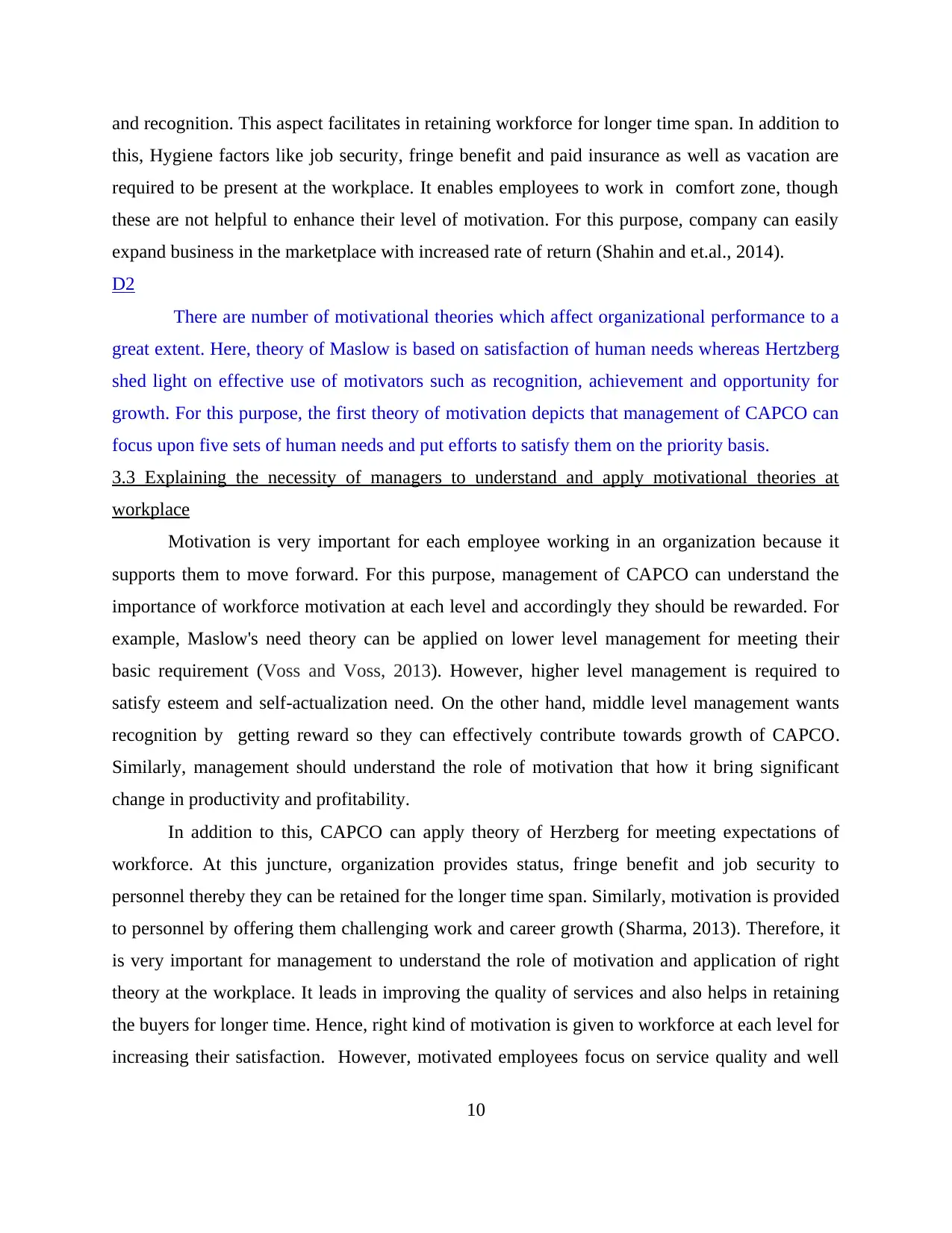
and recognition. This aspect facilitates in retaining workforce for longer time span. In addition to
this, Hygiene factors like job security, fringe benefit and paid insurance as well as vacation are
required to be present at the workplace. It enables employees to work in comfort zone, though
these are not helpful to enhance their level of motivation. For this purpose, company can easily
expand business in the marketplace with increased rate of return (Shahin and et.al., 2014).
D2
There are number of motivational theories which affect organizational performance to a
great extent. Here, theory of Maslow is based on satisfaction of human needs whereas Hertzberg
shed light on effective use of motivators such as recognition, achievement and opportunity for
growth. For this purpose, the first theory of motivation depicts that management of CAPCO can
focus upon five sets of human needs and put efforts to satisfy them on the priority basis.
3.3 Explaining the necessity of managers to understand and apply motivational theories at
workplace
Motivation is very important for each employee working in an organization because it
supports them to move forward. For this purpose, management of CAPCO can understand the
importance of workforce motivation at each level and accordingly they should be rewarded. For
example, Maslow's need theory can be applied on lower level management for meeting their
basic requirement (Voss and Voss, 2013). However, higher level management is required to
satisfy esteem and self-actualization need. On the other hand, middle level management wants
recognition by getting reward so they can effectively contribute towards growth of CAPCO.
Similarly, management should understand the role of motivation that how it bring significant
change in productivity and profitability.
In addition to this, CAPCO can apply theory of Herzberg for meeting expectations of
workforce. At this juncture, organization provides status, fringe benefit and job security to
personnel thereby they can be retained for the longer time span. Similarly, motivation is provided
to personnel by offering them challenging work and career growth (Sharma, 2013). Therefore, it
is very important for management to understand the role of motivation and application of right
theory at the workplace. It leads in improving the quality of services and also helps in retaining
the buyers for longer time. Hence, right kind of motivation is given to workforce at each level for
increasing their satisfaction. However, motivated employees focus on service quality and well
10
this, Hygiene factors like job security, fringe benefit and paid insurance as well as vacation are
required to be present at the workplace. It enables employees to work in comfort zone, though
these are not helpful to enhance their level of motivation. For this purpose, company can easily
expand business in the marketplace with increased rate of return (Shahin and et.al., 2014).
D2
There are number of motivational theories which affect organizational performance to a
great extent. Here, theory of Maslow is based on satisfaction of human needs whereas Hertzberg
shed light on effective use of motivators such as recognition, achievement and opportunity for
growth. For this purpose, the first theory of motivation depicts that management of CAPCO can
focus upon five sets of human needs and put efforts to satisfy them on the priority basis.
3.3 Explaining the necessity of managers to understand and apply motivational theories at
workplace
Motivation is very important for each employee working in an organization because it
supports them to move forward. For this purpose, management of CAPCO can understand the
importance of workforce motivation at each level and accordingly they should be rewarded. For
example, Maslow's need theory can be applied on lower level management for meeting their
basic requirement (Voss and Voss, 2013). However, higher level management is required to
satisfy esteem and self-actualization need. On the other hand, middle level management wants
recognition by getting reward so they can effectively contribute towards growth of CAPCO.
Similarly, management should understand the role of motivation that how it bring significant
change in productivity and profitability.
In addition to this, CAPCO can apply theory of Herzberg for meeting expectations of
workforce. At this juncture, organization provides status, fringe benefit and job security to
personnel thereby they can be retained for the longer time span. Similarly, motivation is provided
to personnel by offering them challenging work and career growth (Sharma, 2013). Therefore, it
is very important for management to understand the role of motivation and application of right
theory at the workplace. It leads in improving the quality of services and also helps in retaining
the buyers for longer time. Hence, right kind of motivation is given to workforce at each level for
increasing their satisfaction. However, motivated employees focus on service quality and well
10
Paraphrase This Document
Need a fresh take? Get an instant paraphrase of this document with our AI Paraphraser
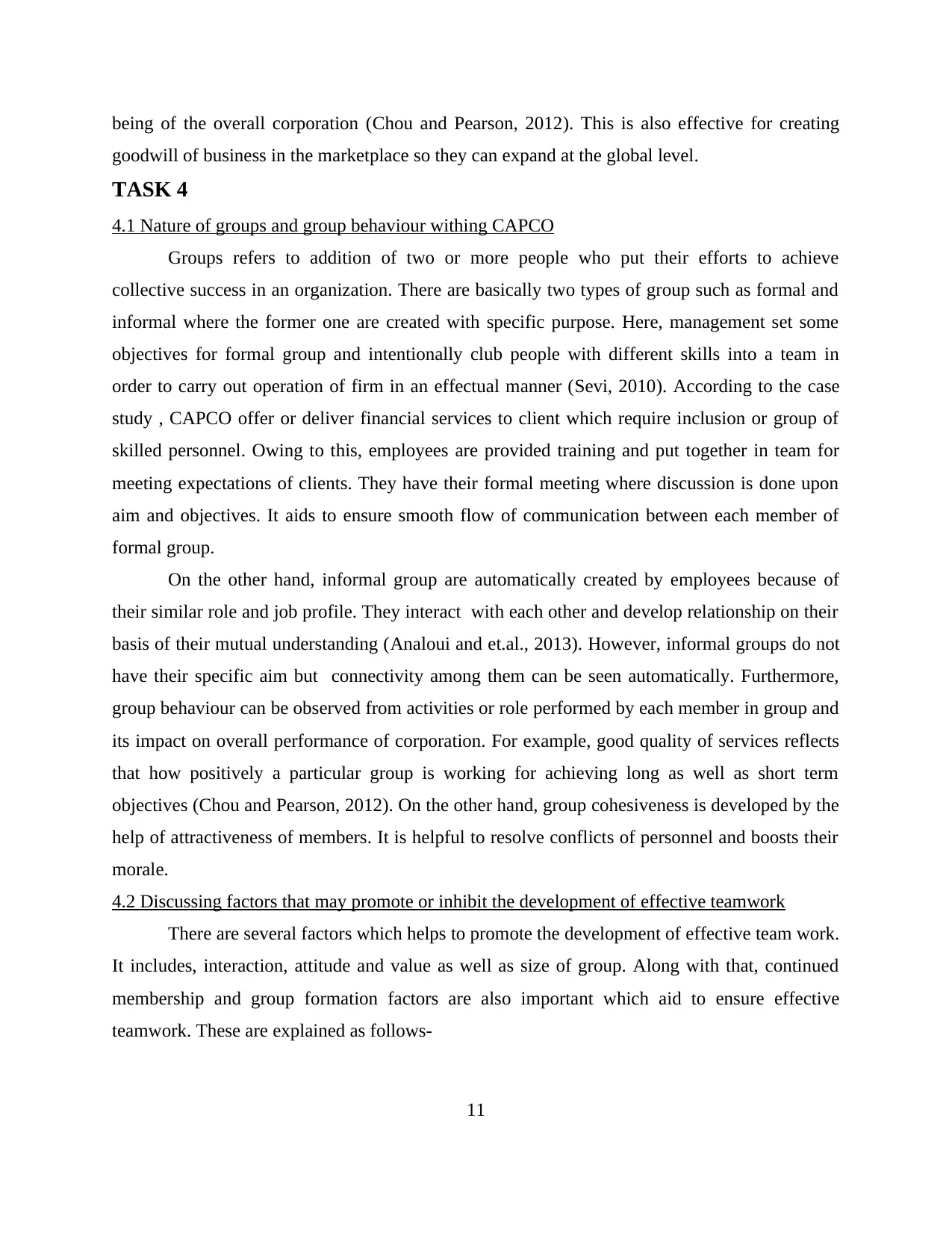
being of the overall corporation (Chou and Pearson, 2012). This is also effective for creating
goodwill of business in the marketplace so they can expand at the global level.
TASK 4
4.1 Nature of groups and group behaviour withing CAPCO
Groups refers to addition of two or more people who put their efforts to achieve
collective success in an organization. There are basically two types of group such as formal and
informal where the former one are created with specific purpose. Here, management set some
objectives for formal group and intentionally club people with different skills into a team in
order to carry out operation of firm in an effectual manner (Sevi, 2010). According to the case
study , CAPCO offer or deliver financial services to client which require inclusion or group of
skilled personnel. Owing to this, employees are provided training and put together in team for
meeting expectations of clients. They have their formal meeting where discussion is done upon
aim and objectives. It aids to ensure smooth flow of communication between each member of
formal group.
On the other hand, informal group are automatically created by employees because of
their similar role and job profile. They interact with each other and develop relationship on their
basis of their mutual understanding (Analoui and et.al., 2013). However, informal groups do not
have their specific aim but connectivity among them can be seen automatically. Furthermore,
group behaviour can be observed from activities or role performed by each member in group and
its impact on overall performance of corporation. For example, good quality of services reflects
that how positively a particular group is working for achieving long as well as short term
objectives (Chou and Pearson, 2012). On the other hand, group cohesiveness is developed by the
help of attractiveness of members. It is helpful to resolve conflicts of personnel and boosts their
morale.
4.2 Discussing factors that may promote or inhibit the development of effective teamwork
There are several factors which helps to promote the development of effective team work.
It includes, interaction, attitude and value as well as size of group. Along with that, continued
membership and group formation factors are also important which aid to ensure effective
teamwork. These are explained as follows-
11
goodwill of business in the marketplace so they can expand at the global level.
TASK 4
4.1 Nature of groups and group behaviour withing CAPCO
Groups refers to addition of two or more people who put their efforts to achieve
collective success in an organization. There are basically two types of group such as formal and
informal where the former one are created with specific purpose. Here, management set some
objectives for formal group and intentionally club people with different skills into a team in
order to carry out operation of firm in an effectual manner (Sevi, 2010). According to the case
study , CAPCO offer or deliver financial services to client which require inclusion or group of
skilled personnel. Owing to this, employees are provided training and put together in team for
meeting expectations of clients. They have their formal meeting where discussion is done upon
aim and objectives. It aids to ensure smooth flow of communication between each member of
formal group.
On the other hand, informal group are automatically created by employees because of
their similar role and job profile. They interact with each other and develop relationship on their
basis of their mutual understanding (Analoui and et.al., 2013). However, informal groups do not
have their specific aim but connectivity among them can be seen automatically. Furthermore,
group behaviour can be observed from activities or role performed by each member in group and
its impact on overall performance of corporation. For example, good quality of services reflects
that how positively a particular group is working for achieving long as well as short term
objectives (Chou and Pearson, 2012). On the other hand, group cohesiveness is developed by the
help of attractiveness of members. It is helpful to resolve conflicts of personnel and boosts their
morale.
4.2 Discussing factors that may promote or inhibit the development of effective teamwork
There are several factors which helps to promote the development of effective team work.
It includes, interaction, attitude and value as well as size of group. Along with that, continued
membership and group formation factors are also important which aid to ensure effective
teamwork. These are explained as follows-
11

Interaction or communication-This is the most important aspect which help to inhibit
the development of effective team work is lack of communication (Davey and et.al.
2013). This is because of busy schedule which make workforce aimless that affect overall
work of corporation. For this purpose, free flow of communication is required in the form
of formal or informal meeting for successful operation of CAPCO. Group formation factors-There are several group formation factors such as common
interests, shared goals which proves to be effective for personnel to combine in single
team. It enables employees to assist each other for completing the particular task and
accomplish objectives set on the basis of team (Analoui and et.al., 2013). Size of group-The larger size of group tend to affect team workforce to a great extent
because they degree of cohesiveness is decreased with increased number of personnel.
On the other hand, small size of group have more interaction and clarity of goals that help
to ensue effectiveness of team.
Attitude and values-It is very important for personnel to have shared values and positive
attitude. This facilitates to ensure great cohesiveness of team which in turn accomplish
objectives (Nenaber, 2010). On the contrary, because of negative attitude in some of team
members, work can be affected badly.
4.3 Evaluating the impact of technology on team functioning within CAPCO
Technological innovation affect performance of corporation to a great extent because it
support firms to complete their business transaction in relatively less time. In modern era
CAPCO uses internet for completing each and every business activities. For this purpose, email
is used between team members for floating information related to their task (Lussier and
Corman, 2015). It proves to be effective for smooth operation of corporation. E-mail is the
effective method for dissemination of information among all team or department which
facilitates company to achieve the heights.
Furthermore, virtual teams are also created with the technological support. It assists
CAPCO to get good quality of services in accordance with demand of clients. Moreover,
technological aspect also ensure connectivity of team members by reducing the barrier of long
distance. Similarly, server system is also there in CAPCO which ensure better connectivity
among all group members. This leads to integrate them as team and support company in
12
the development of effective team work is lack of communication (Davey and et.al.
2013). This is because of busy schedule which make workforce aimless that affect overall
work of corporation. For this purpose, free flow of communication is required in the form
of formal or informal meeting for successful operation of CAPCO. Group formation factors-There are several group formation factors such as common
interests, shared goals which proves to be effective for personnel to combine in single
team. It enables employees to assist each other for completing the particular task and
accomplish objectives set on the basis of team (Analoui and et.al., 2013). Size of group-The larger size of group tend to affect team workforce to a great extent
because they degree of cohesiveness is decreased with increased number of personnel.
On the other hand, small size of group have more interaction and clarity of goals that help
to ensue effectiveness of team.
Attitude and values-It is very important for personnel to have shared values and positive
attitude. This facilitates to ensure great cohesiveness of team which in turn accomplish
objectives (Nenaber, 2010). On the contrary, because of negative attitude in some of team
members, work can be affected badly.
4.3 Evaluating the impact of technology on team functioning within CAPCO
Technological innovation affect performance of corporation to a great extent because it
support firms to complete their business transaction in relatively less time. In modern era
CAPCO uses internet for completing each and every business activities. For this purpose, email
is used between team members for floating information related to their task (Lussier and
Corman, 2015). It proves to be effective for smooth operation of corporation. E-mail is the
effective method for dissemination of information among all team or department which
facilitates company to achieve the heights.
Furthermore, virtual teams are also created with the technological support. It assists
CAPCO to get good quality of services in accordance with demand of clients. Moreover,
technological aspect also ensure connectivity of team members by reducing the barrier of long
distance. Similarly, server system is also there in CAPCO which ensure better connectivity
among all group members. This leads to integrate them as team and support company in
12
⊘ This is a preview!⊘
Do you want full access?
Subscribe today to unlock all pages.

Trusted by 1+ million students worldwide
1 out of 15
Related Documents
Your All-in-One AI-Powered Toolkit for Academic Success.
+13062052269
info@desklib.com
Available 24*7 on WhatsApp / Email
![[object Object]](/_next/static/media/star-bottom.7253800d.svg)
Unlock your academic potential
Copyright © 2020–2025 A2Z Services. All Rights Reserved. Developed and managed by ZUCOL.





